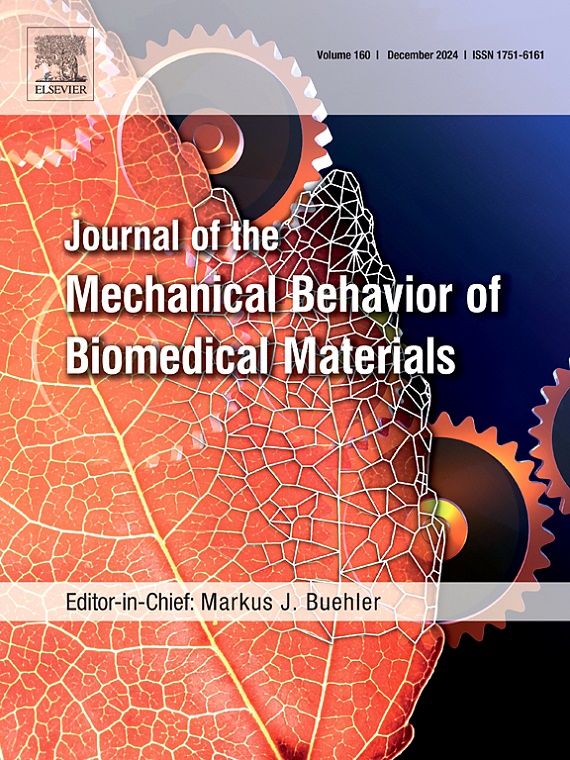中空结构聚合物复合材料微针的仿生设计与有限元分析
IF 3.5
2区 医学
Q2 ENGINEERING, BIOMEDICAL
Journal of the Mechanical Behavior of Biomedical Materials
Pub Date : 2025-07-11
DOI:10.1016/j.jmbbm.2025.107135
引用次数: 0
摘要
间质液(ISF)是一种在真皮细胞中发现的含有不同类型生物标志物的体液。微针已被开发用于透皮应用,如药物输送和皮肤液体的提取。本研究利用微数字光处理(μDLP)技术制备了一种钢笔型空心微针(HMN)贴片。研究了高分辨率HMN的最佳设计参数和打印角度。此外,ANSYS有限元分析(FEA)计算得出,单个针尖的最大von-Mises应力为3.291 MPa,大于表面阻力值3.183 MPa。简单应力,如拉应力或压应力,测量在一个方向上施加在单位面积上的力。相反,冯-米塞斯应力结合了来自多个方向的应力。这种方法可以更准确地预测微针在复杂载荷条件下的失效。最大总变形量为6.1034 μm,小于微针长度。此外,还引入了碳化硅(SiC)作为填充陶瓷材料来制备空心微针贴片。本文章由计算机程序翻译,如有差异,请以英文原文为准。
Bio-inspired design and finite element analysis of polymer composite microneedles with hollow architecture
Interstitial fluid (ISF) is a body fluid found in dermal cells containing different types of biomarkers. Microneedles have been developed for transdermal applications such as drug delivery and the extraction of dermal fluids. In this study, a micro digital light processing (μDLP) technique is utilized to fabricate a fountain pen inspired hollow microneedle (HMN) patch. This research focused on evaluating the optimal design parameters and print angle of HMN with high resolution. Furthermore, ANSYS finite element analysis (FEA) evaluated that the maximum von-Mises stress of individual needle tip is 3.291 MPa which is greater than the skin resistance value of 3.183 MPa. Simple stress, such as tensile or compressive stress, measures force per unit area applied in one direction. In contrast, von-Mises stress combines stresses from multiple directions. This approach provides a more accurate prediction of failure in microneedles under complex loading conditions. In addition to that, the maximum total deformation is 6.1034 μm which is smaller than the length of the microneedle. Moreover, Silicon Carbide (SiC) is introduced as filler ceramic material to fabricate the hollow microneedle patch.
求助全文
通过发布文献求助,成功后即可免费获取论文全文。
去求助
来源期刊

Journal of the Mechanical Behavior of Biomedical Materials
工程技术-材料科学:生物材料
CiteScore
7.20
自引率
7.70%
发文量
505
审稿时长
46 days
期刊介绍:
The Journal of the Mechanical Behavior of Biomedical Materials is concerned with the mechanical deformation, damage and failure under applied forces, of biological material (at the tissue, cellular and molecular levels) and of biomaterials, i.e. those materials which are designed to mimic or replace biological materials.
The primary focus of the journal is the synthesis of materials science, biology, and medical and dental science. Reports of fundamental scientific investigations are welcome, as are articles concerned with the practical application of materials in medical devices. Both experimental and theoretical work is of interest; theoretical papers will normally include comparison of predictions with experimental data, though we recognize that this may not always be appropriate. The journal also publishes technical notes concerned with emerging experimental or theoretical techniques, letters to the editor and, by invitation, review articles and papers describing existing techniques for the benefit of an interdisciplinary readership.
 求助内容:
求助内容: 应助结果提醒方式:
应助结果提醒方式:


